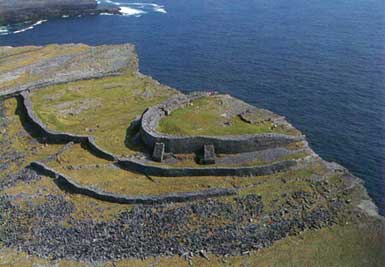Dun Aengus is a fort situated on the edge of a cliff at a height of 100 meters overlooking the Atlantic on the Aran Island of Inishmore. It consists of a series of concentric circular walls, the innermost; the citadel encloses an area approximately 50 meters in diameter with 4m thick walls of stone. These walls have been rebuilt to a height of 6m and have wall walks, chambers, and flights of stairs as well.
Before the Late Bronze Age (1500-600BC), people most likely lived in several small communities that all held the same status. But in the Late Bronze Age, chiefdoms emerged. Chiefdoms combined the small local groups into a single, unified group under one leader, with farms and homes clustered around the mammoth forts like Dun Aengus.
But there wasn’t just one chiefdom. Oh no. There were many chiefdoms. And between these chiefdoms you had alliances and competitions. It was important to appear as strong as possible so that you could wield the most power to protect your land.
So think about Dun Aengus. What can we learn about the people who built it from looking at it? (Keep in mind that there have been restorations done to the fort over time, but we can operate under the assumption that it’s largely very similar to what it originally looked like).
Dun Aengus is a hillfort, located at the top of a 300 foot high cliff, on the Atlantic Ocean side of the island. At first glance this seems like a strange place to build a fort. If you’re attacked from the north, you’re sandwiched between your own walls and the sea.
But Dun Aengus looks out upon what was probably a prehistoric sea-trading route. From this height, the chiefdom at Dun Aengus could keep a lookout for ships passing through, and see whether they were friends or enemies. The fort would also have been visible from the sea, and would signal to the travelers on the boat that this land, this sea-route, belonged to someone, and that someone had a massive fort, and was watching YOU.
The walls of Dun Aengus are extremely thick, and were probably even higher than they are now. There are actually four walls that make up the fort (it’s hard to see the other two, but they’re there). And the massive chevaux-de-frise – the minefield of stones sticking up out of the ground – was meant to impede invaders on their way to the fort.
Press Releases
 Canada Journal – News of the World Articles and videos to bring you the biggest Canadian news stories from across the country every day
Canada Journal – News of the World Articles and videos to bring you the biggest Canadian news stories from across the country every day



